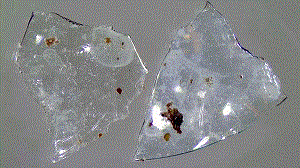
Filters keep some nonbiological waste out of wastewater treatment plants, said Rolf Halden, the director of the Center for Environmental Health Engineering at Arizona State University, and Charles Rolsky, a graduate student and the studys lead author. (Dr. Halden uses contact lenses; Mr. Rolsky wears glasses.) But contacts are so flexible that they can fold up and make their way through. The researchers interviewed workers at such facilities, who confirmed that they had spotted lenses in the waste.
Next, the team submerged contacts in chambers where bacteria are used to break down biological waste at a treatment plant. They found that even after seven days of exposure, the lenses appeared intact, though lab analysis detected small changes in the material. These are medical devicesyou would not expect them to be super-biodegradable, Dr. Halden said. Good for the contact lens wearer during use, not so good when the things get out into the environment.
Then, going through about nine pounds of treated waste, Mr. Rolsky and a colleague found two fragments of contact lens, implying that while microorganisms might not make much of a mark, physical processing might break them into pieces. Tiny bits of plastic from many sources have been spotted in the oceans and other bodies of water, where they may be ingested by fish, corals and other animals. The fragments can carry high loads of pollutants absorbed from their surroundings, so the organisms get a dose of these substances as well.
After processing, treated waste is often spread on fields. If fragments of contacts are in the mixture, they or the substances theyve picked up may be washed by rain into surface water, the researchers conjecture. They estimate that billions of contact lensesweighing at least 22 metric tonsmay be flushed in the United States every year.
Contact lens packages dont currently tell users how to dispose of them, said Dr. Halden, who suggested that companies should add labels recommending that contacts be put in the garbage rather than washed down the drain. He pointed out that some manufacturers have already begun recycling programs to reclaim the plastic from lenses. While contact lenses are far from the largest source of microplastic pollution in water, they appear to be a readily avoidable one.
Mr. Rolsky said the findings had given him an additional incentive to stick with his preference for wearing glasses. This just gives me a reason, he said with a laugh, to solidify that for the rest of time.
Greenwood, Veronique, Before You Flush Your Contact Lenses, You Might Want to
Know This, Houston Chronicle from The New York Times, August 19, 2018


